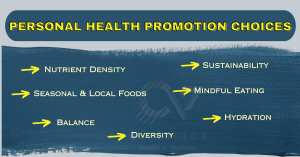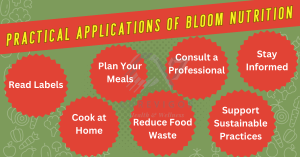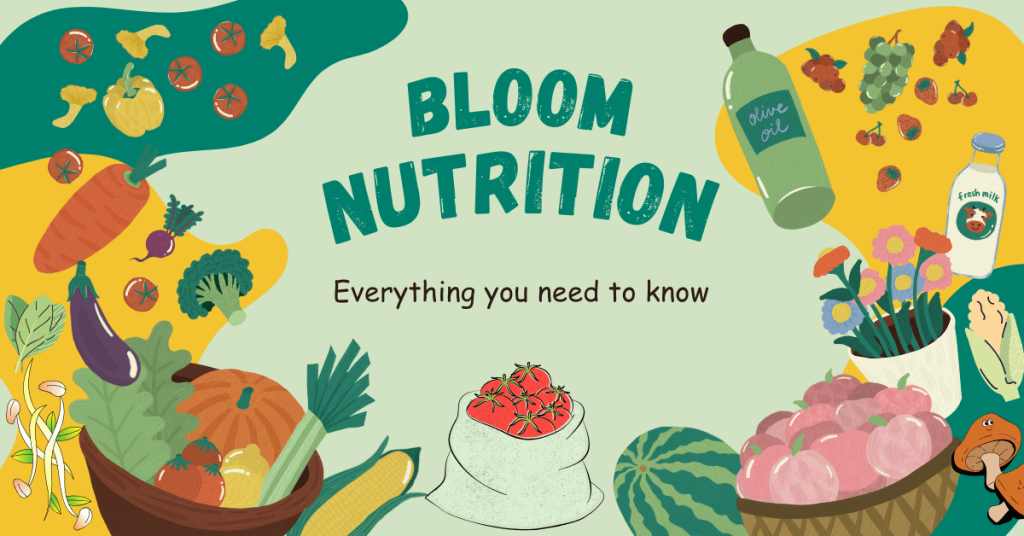Contents
Bloom Nutrition: Everything You Need to Know
Bloom Nutrition: Your Comprehensive Guide to a Healthier You. Discover Everything You Need to Know for Vibrant Well-being.
Nutrition is the cornerstone of a healthy lifestyle. It’s the fuel that powers our bodies, influences our overall well-being, and plays a pivotal role in our long-term health. One term that has recently gained significant attention is “Bloom Nutrition.” But what exactly does it mean, and why should you care about it? This blog post will explore Bloom Nutrition’s concept, significance, principles, and practical applications.
What Is Bloom Nutrition?
Bloom Nutrition is a holistic eating approach beyond counting calories or macronutrients. Its philosophy emphasizes nourishing your body with nutrient-dense foods while considering the broader impact of your food choices on your well-being and the environment. It’s about making choices that promote personal and the planet’s health.

1. Nutrient Density
Nutrient density is at the heart of Bloom Nutrition. Instead of merely counting calories, focus on the nutritional value of your foods. Here’s a breakdown:
a. Essential Nutrients: Prioritize foods that are rich in essential nutrients such as vitamins (like vitamin C, vitamin D, and vitamin K), minerals (such as calcium, iron, and magnesium), and other bioactive compounds (like antioxidants and phytonutrients).
b. Whole Foods: Choose whole, minimally processed foods over highly processed and refined options. Whole foods are packed with nutrients and are often less calorie-dense.
c. Balanced Diet: Ensure that your meals include a variety of nutrient-dense foods. Consider leafy greens, colorful fruits and vegetables, whole grains, lean proteins (like poultry, fish, and legumes), and healthy fats (such as avocados, nuts, and olive oil).
d. Pay attention to micronutrients, such as vitamins and minerals. They play critical roles in supporting various bodily functions and overall health.
2. Mindful Eating
Mindful eating is a practice that encourages you to be fully present during meals. Here’s why it’s a fundamental principle of Bloom Nutrition:
a. Slow Down: Eating slowly allows you to savor the flavors and textures of your food. It also gives your body time to send signals of fullness to your brain, reducing the risk of overeating.
b. Listen to Your Body: b. Listen to Your Body: Know your body’s hunger and fullness signals. Eat when you’re hungry and stop when you’re satisfied, not when your plate is empty.
c. Enjoy the Experience: Engage your senses while eating. Notice the colors, smells, and tastes of your food. Your relationship with food becomes more profound when you do this.
d. Decreased Emotional Eating: You can recognize emotional triggers for overeating and create healthy coping skills with the help of mindful eating.
3. Seasonal and Local Foods
Choosing seasonal and local foods aligns with Bloom Nutrition’s emphasis on sustainability and nutrition:
a. Freshness and Nutrient Density: Seasonal and local produce is often fresher and more nutrient-dense because it’s picked at its peak ripeness and doesn’t need to travel long distances.
b. Reduced Carbon Footprint: Supporting local farmers and purchasing seasonal foods can significantly reduce the environmental impact of your diet by decreasing the need for long-distance transportation.
c. Taste and Variety: Seasonal foods offer a rotating variety in your diet, making meals more exciting and diverse throughout the year.
4. Diversity
Diversity in your diet is vital for achieving optimal health:
a. Nutrient Variety: Different foods provide different sets of nutrients. Consuming a wide range of foods ensures you obtain a broad spectrum of vitamins, minerals, and antioxidants.
b. Gut Health: A diverse diet supports a healthy gut microbiome, which plays a crucial role in digestion, immune function, and mental health.
c. Reduced Allergen Risk: A diverse diet may reduce the risk of developing food allergies or intolerances, as repetitive exposure to the same foods can increase sensitivities.
5. Sustainability
Sustainability is a core aspect of Bloom Nutrition, taking into account the environmental impact of your food choices:
a. Sustainable Sourcing: Choose foods that are sustainably produced and harvested. Regenerative agriculture, responsible fishing, and ethical animal husbandry are all examples of practices we can support.
b. Reduced Waste: Minimize food waste to lessen your contribution to landfill and resource depletion. Utilize leftovers in inventive ways and compost food waste.
c. Carbon Footprint: Be mindful of the carbon footprint of your diet. Consider reducing or eliminating high-impact foods like red meat, which has a larger environmental footprint.
6. Balance
Achieving balance in your diet is crucial for overall health:
a. Macronutrient Proportions: Strive for a balanced intake of carbohydrates, proteins, and fats. The body requires each macronutrient for a unique purpose, so it is essential to pay attention to them.
b. Portion Control: Maintain appropriate portion sizes to prevent overconsumption of calories, which can lead to weight gain and related health issues.
c. Customization: Seek guidance from a registered dietitian to create a balanced eating plan tailored to your needs, goals, and dietary restrictions.
7. Hydration
Staying well-hydrated is fundamental to overall health and is often overlooked:
a. Bodily Functions: Water is essential for nearly every bodily function, from digestion and nutrient absorption to temperature regulation and waste removal.
b. Energy Levels: Dehydration can lead to fatigue and reduced physical and cognitive performance. Drinking enough water keeps your energy levels stable throughout the day.
c. Hydration Needs: Your hydration needs can vary based on activity level, climate, and overall health. Pay attention to your body’s signals to ensure you drink enough water.
Incorporating these principles of Bloom Nutrition into your daily life can help you make healthier, more sustainable food choices that benefit your well-being and the planet’s health. By embracing these principles, you’ll develop a more mindful and holistic approach to nutrition that supports a thriving, balanced lifestyle.
Practical Applications of Bloom Nutrition

So, how can you put Bloom Nutrition into practice in your daily life? Here are some actionable steps:
1. Plan Your Meals
Creating a well-thought-out meal plan is a cornerstone of Bloom Nutrition. Here’s how to do it effectively:
a. Balanced Diet: Ensure your meal plan includes balanced macronutrients – carbohydrates, proteins, and fats. This balance provides sustained energy throughout the day and supports various bodily functions.
b. Portion Control: Watch the size of your portions to avoid overeating. Use measuring cups, a food scale, or simply your hand as a guide for appropriate parts of different food groups.
c. Weekly Planning: Plan your meals for the week in advance. You’ll save time while shopping and avoid choosing less healthy, convenient options on busy days.
d. Batch Cooking: Consider batch cooking and meal prepping. Cook more prominent quantities of healthy meals and store them in portion-sized containers for quick and nutritious meals on the go.
e. Snack Smart: Include healthy snacks in your meal plan to keep your energy levels stable between meals. Opt for options like nuts, yogurt, or cut-up vegetables and fruits.
2. Read Labels
Reading food labels is essential for making informed choices while shopping:
a. Look at the ingredient list. Ingredients are generally listed in descending order of weight. Choose products with fewer recognizable and whole-food ingredients.
b. Nutritional Information: Check the nutrition facts panel for information on calories, macronutrients, fiber, and vitamins and minerals. Pay attention to added sugars, salt, and bad fats.
c. Allergens: If you have food allergies or intolerances, carefully read labels to identify potential allergens or problem ingredients.
d. Date Labels: Pay attention to “use by” and “best before” dates to ensure the freshness and safety of products.
3. Cook at Home
Cooking at home allows you to take control of your nutrition and culinary creativity:
a. Fresh Ingredients: Start with fresh, whole ingredients. Experiment with different fruits, vegetables, and herbs to add variety and flavor to your dishes.
b. Recipe Exploration: Try new recipes and cooking techniques. Keeping your meals interesting will encourage you to try more nutritious foods.
c. Portion Control: You can easily control portion sizes at home, helping you manage your calorie intake.
d. Reduced Sodium and Sugar: Cooking at home allows you to reduce excessive salt and sugar, often added to restaurants and processed foods.
4. Reduce Food Waste
Minimizing food waste is both eco-friendly and wallet-friendly:
a. Meal Planning: Plan your meals to use up perishable ingredients before they go wrong—design meals around what you have in your pantry and refrigerator.
b. Composting: Consider composting food scraps and non-edible parts of fruits and vegetables. Doing this action reduces landfill waste and produces nutrient-rich compost for your garden.
c. Freezing: Freeze leftovers or excess food to extend their shelf life. This way, you can enjoy them later without worrying about spoilage.
5. Support Sustainable Practices
Choosing sustainable products and brands aligns with the principles of Bloom Nutrition:
a. Ethical Sourcing: Look for food products that support fair trade and ethical sourcing practices. You can apply it to coffee, chocolate, and other globally sourced foods.
b. Sustainable Seafood: Opt for sustainably sourced seafood to help protect our oceans and marine life. Could you look for certificates from the Marine Stewardship Council, for example?
c. Eco-Friendly Packaging: Consider minimal and eco-friendly packaging products to reduce waste. Also, support brands that use recyclable or biodegradable materials.
6. Stay Informed
Knowledge is an effective tool for making wise decisions:
a. Nutrition News: Stay updated on the latest nutrition research and trends. Follow reputable nutrition websites, read books, and consult with registered dietitians for reliable information.
b. Sustainable Practices: Keep abreast of sustainability issues, such as climate change, food waste, and ethical farming practices. Understanding these issues can motivate you to make more sustainable food choices.
7. Consult a Professional
When in doubt or if you have specific dietary needs or health concerns, seeking professional guidance is a wise choice:
a. Registered Dietitian: A registered dietitian can provide personalized nutrition advice tailored to your unique health goals and dietary requirements. They can help you create a meal plan that suits your needs.
b. Nutritionist: Nutritionists can offer valuable guidance on general nutrition and healthy eating practices. However, ensure they have relevant qualifications and certifications.
Incorporating these practical applications of Bloom Nutrition into your daily life can lead to better health, reduced environmental impact, and a deeper appreciation for the connection between what you eat and how it impacts both your health and the environment. Remember that minor adjustments can significantly impact, so begin with one or two of these habits and expand from there.
The Bottom Line
Bloom Nutrition is a holistic approach to eating that considers your health and the planet’s health. By prioritizing nutrient-dense foods, mindful eating, sustainability, and balance, you can nourish your body and contribute to a more sustainable and resilient food system. Remember that making lasting changes to your diet takes time, so start small and gradually incorporate these principles into your daily life. Your body will appreciate you for it, as will the environment.
FAQs on Bloom Nutrition
Q1: What are nutrient-dense foods, and why are they essential in Bloom Nutrition?
A1: Nutrient-dense foods provide many essential nutrients, such as vitamins, minerals, and antioxidants, relative to their calorie content. These foods are vital in Bloom Nutrition because they nourish your body effectively, promoting good health and well-being without excessive calorie intake.
Q2: How can I practice mindful eating, and what are its benefits?
A2: Mindful eating involves being fully present during meals, savoring each bite, and listening to your body’s hunger and fullness cues. Benefits include improved portion control, better digestion, reduced emotional eating, and a more enjoyable eating experience.
Q3: Why is supporting local and seasonal foods encouraged in Bloom Nutrition?
A3: Choosing local and seasonal foods aligns with Bloom Nutrition’s sustainability principles. These foods are often fresher, more nutrient-dense, and have a lower carbon footprint because they don’t require long-distance transportation. Supporting local farmers also strengthens the local economy.
Q4: How can I incorporate diversity into my diet, and why is it important?
A4: Incorporate diversity by consuming various foods from various food groups. It’s essential because different foods offer unique nutrients. A diverse diet provides a broad spectrum of vitamins, minerals, and other vital compounds, supporting overall health.
Q5: What does sustainability mean in the context of Bloom Nutrition?
A5: Sustainability in Bloom Nutrition involves choosing foods produced and harvested to minimize environmental impact. All this includes supporting practices like ethical animal farming, responsible fishing, and reducing food waste to protect the planet’s resources.
Q6: How can I balance my diet, and why is it necessary?
A6: Ensure balanced meals include appropriate carbohydrates, proteins, and fats proportions. It’s crucial because each macronutrient serves specific functions in your body. A balanced diet supports overall health and prevents nutrient imbalances.
Q7: Why is staying hydrated important in Bloom Nutrition?
A7: Hydration is vital because water is essential for almost every bodily function. It supports digestion, nutrient absorption, temperature regulation, and waste removal. Staying hydrated ensures your body functions optimally and maintains energy levels.
Conclusion
Bloom Nutrition is a holistic approach to eating that prioritizes nutrient-dense foods, mindful eating, sustainability, diversity, balance, and hydration. By embracing these principles, you can improve your health, reduce your environmental impact, and develop a deeper connection with the food you consume.
Remember that implementing these principles doesn’t require drastic changes all at once. Start with small steps, and gradually incorporate them into your daily life. Whether you want to enhance your well-being or contribute to a healthier planet, Bloom Nutrition offers a thoughtful and practical framework for achieving these goals through dietary choices.
Read more articles on Health & Wellness.



